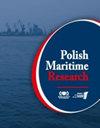Design and Operational Diagnostics of Marine Propellers Made of Polymer Materials
IF 2
3区 工程技术
Q2 ENGINEERING, MARINE
引用次数: 0
Abstract
Abstract There has been a rapidly growing interest in the use of composite and polymer materials for the construction of marine propellers for over 20 years. The main advantages of these materials are a reduction in the weight of the propeller, increased efficiency due to the hydroelasticity effect, a reduction of the hydroacoustic signature, and a cost reduction for serial production. This paper presents an overview of diagnostic methods that can be applied at the design level and during the operation of marine propellers made of polymeric materials. Non-invasive contact and non-contact-based diagnostic techniques for evaluating the technical state of the propeller are reviewed, and the advantages and disadvantages of qualitative and quantitative methods are identified. Operational diagnostic procedures for propellers are areessential for the safety of vessels at sea. Finally, the structure of a diagnostic system is proposed. It combined diagnosis process with the genesis of damage and the prognosis of the technical condition, i.e. production and in-service diagnostics.船用高分子材料螺旋桨的设计与运行诊断
摘要20多年来,人们对使用复合材料和聚合物材料建造船用螺旋桨的兴趣迅速增长。这些材料的主要优点是减少了螺旋桨的重量,由于水弹性效应而提高了效率,减少了水声特征,并且降低了批量生产的成本。本文概述了可应用于聚合物材料船用螺旋桨设计水平和运行过程中的诊断方法。综述了用于评估螺旋桨技术状态的无创接触和基于非接触的诊断技术,并确定了定性和定量方法的优缺点。螺旋桨的操作诊断程序对海上船只的安全至关重要。最后,提出了诊断系统的结构。它将诊断过程与损伤的发生和技术条件的预测相结合,即生产和在役诊断。
本文章由计算机程序翻译,如有差异,请以英文原文为准。
求助全文
约1分钟内获得全文
求助全文
来源期刊

Polish Maritime Research
工程技术-工程:海洋
CiteScore
3.70
自引率
45.00%
发文量
20
审稿时长
>12 weeks
期刊介绍:
The scope of the journal covers selected issues related to all phases of product lifecycle and corresponding technologies for offshore floating and fixed structures and their components.
All researchers are invited to submit their original papers for peer review and publications related to methods of the design; production and manufacturing; maintenance and operational processes of such technical items as:
all types of vessels and their equipment,
fixed and floating offshore units and their components,
autonomous underwater vehicle (AUV) and remotely operated vehicle (ROV).
We welcome submissions from these fields in the following technical topics:
ship hydrodynamics: buoyancy and stability; ship resistance and propulsion, etc.,
structural integrity of ship and offshore unit structures: materials; welding; fatigue and fracture, etc.,
marine equipment: ship and offshore unit power plants: overboarding equipment; etc.
 求助内容:
求助内容: 应助结果提醒方式:
应助结果提醒方式:


